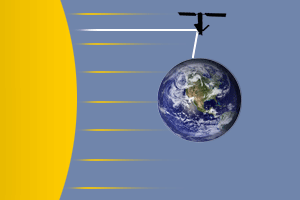
Animation courtesy of Andreas Moller
 Copyright © Michael Richmond.
This work is licensed under a Creative Commons License.
Copyright © Michael Richmond.
This work is licensed under a Creative Commons License.
This project must be done by individuals.
There are many satellites orbiting the Earth. One series of over 50 identical craft are the Iridium satellites. They are all in low-Earth orbits, and, since there are so many, there are always one or two or three passing overhead at any time.
Now, what makes these particular satellites interesting are two features:
It turns out that, every now and then, the antenna of one of these satellites will be oriented so that it reflects sunlight down to the Earth's surface, creating a brief "flare" of light.

Animation courtesy of
Andreas Moller
If you are lucky enough to be standing at the right location on Earth, you can see a flash of light that lasts for 5-10 seconds and is brighter than any star or planet (but not as bright as the Moon).
But where and when should you look? Fortunately, the good folk at Heavens Above have done all the hard work for you.
If you find a good candidate, you can click on the link for it to generate a chart showing the location of the flare in the sky.
So, here's your assignment to receive extra credit:
What should you do if it's cloudy when your chosen flare is happening? Just pick another night and try again.
Turn in your report and any pictures you took, in hardcopy. In addition, please send me any pictures via E-mail.
 Copyright © Michael Richmond.
This work is licensed under a Creative Commons License.
Copyright © Michael Richmond.
This work is licensed under a Creative Commons License.